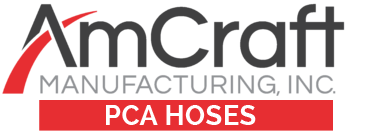There are different types of PCA hoses that work for different applications. Depending on how often employees use PCA hoses, they should consider what hoses will benefit them the most when working with different aircraft. Lay flat and rigid duct hoses provide different designs for various uses, helping aircraft maintenance personnel work more efficiently in preserving air quality and temperatures.
Flat Hoses
Unlike other PCA hoses, flat hoses are designed for more convenient storage, folding completely flat when not in use. They are ideal for personnel who require quick and efficient storage that allows more room for other hoses or equipment. Flat hoses also resist tearing while providing an entirely airtight RF welded seal, and they come in different models depending on the applications for which they’re needed. Custom lengths, diameters and end fittings are available to meet specific requirements as well.
Rigid Duct Hoses
Although rigid duct hoses are not specifically designed for ease of storage, they are fabricated to resist tearing and kinking with divided sections. These flexible ducts contain wire pitches that allow pre-conditioned air to flow through regardless of the hose’s position. Rigid duct hoses work for aircraft maintenance that requires ample maneuverability, giving personnel the chance to work with hard-to-reach aircraft ports. Hose hanger slings are also useful, holding rigid duct hoses in place beneath a jet bridge to help further avoid kinks and restrictions.
Choose What Works
When choosing PCA hoses for aircraft air quality control there are multiple designs to select, each with its own advantages. Both rigid duct and flat hoses are designed to keep insulated air in while preventing leakage or contamination, and all are made for convenience of storage. With PCA hoses, ground support crews have full control over temperature and humidity in aircraft cabins.
